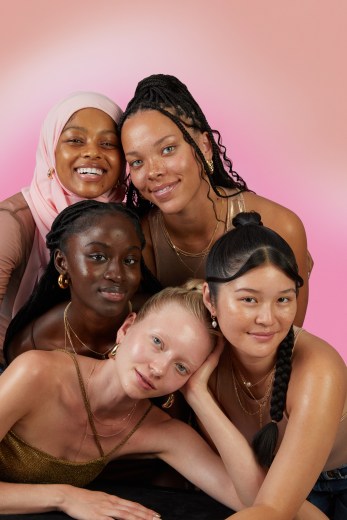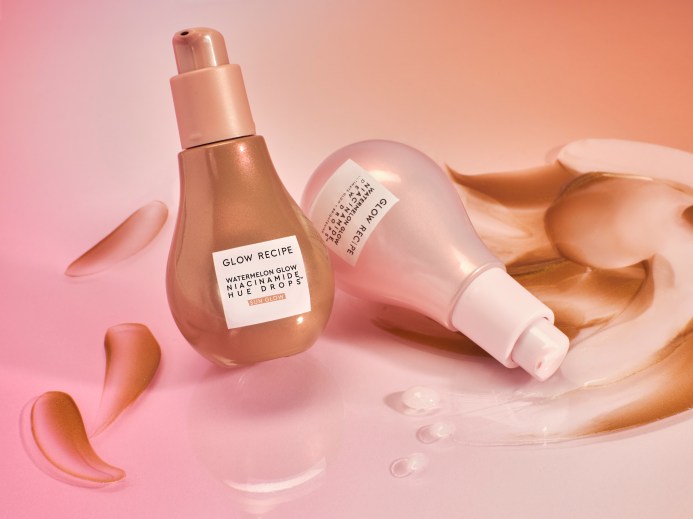To receive the Glossy Pop newsletter in your inbox every Friday, click here.
All products featured on Glossy Pop are independently selected by our editorial team. However, when you buy something through our retail links, we may earn an affiliate commission.
On January 16, the influencer Aysha Harun (458,000 followers) posted a video to TikTok labeled, “Did I accidentally get sent an unreleased Glow Recipe product?” Harun is on Glow Recipe’s diversity board for which she is paid for her time, but she was not paid to post this video. And, because of the post, which went viral, the brand had to pivot from its original launch strategy for the product and figure out how to proceed.
The new product — a bronzing, tinted version of Glow Recipe’s many-times-viral Watermelon Glow Niacinamide Dew Drops Serum — wasn’t set to launch until February 23. But by February 2, Harun’s video had 3.2 million views, over 315,000 likes, over 4000 comments and over 27,000 saves. In addition, posts about the product made by creators who have not been seeded product, have generated over 1 million views.
It was because Harun is on the diversity board that she received the product early — all members of the board were sent the new product, but, due to human error, there was no note informing them that it was under embargo. “Glow Recipe, I’m sorry if I’m leaking your product. I don’t know anything about this. I did not receive a notice to not share this, so please do not sue me,” Harun said in her post, as she demonstrated applying the new Watermelon Glow Niacinamide Hue Drops Sun Glow Serum. “But I love it. And I think the girls are gonna love it, too.”
“The world of social media is not always predictable,” said Sarah Lee, Glow Recipe co-founder and co-CEO, in reaction to the leak. The brand’s immediate response was to scratch its set embargo date for influencers and press, but it decided not to push up the product’s launch date. That said, it chose to pivot its seeding strategy, embracing the organic excitement that Harun showed for the product which quickly filled up her video’s comments section.
“This was just an organic post. She was authentically excited to share her review [and] reveal; it was so authentic. I think that’s what drove so much of the attention,” Lee said. She noted that it has been organic buzz that has driven much of the brand’s growth, to date. Still, Glow Recipe has invested in plenty of paid partnerships — it will for this product, too, closer to its launch date. “The paid strategy is always there, but it’s been such a small portion of the growth,” Lee said.
Ad position: web_incontent_pos1
As Harun’s video picked up steam, Glow Recipe’s team began to brainstorm. “We paused, and we saw how amazing the product looked on her skin. And that wowed us,” Lee said. “People were genuinely intrigued and celebrating the look [in the comments]. … The reaction [was] so positive, she did look incredible … and she was authentically excited about the product. [So we said,] ‘Let’s just let it flow.'”
“It’s our job as a brand and part of this community to react quickly and give the people and the creators what they want,” said Christine Chang, Glow Recipe co-founder and co-CEO.
Simultaneously, Stevie Chong, Glow Recipe’s senior director of global PR and influencer strategy, was getting texts from influencers wanting to try the Hue Drops, too. The brand quickly overnighted boxes to about 40 other influencers, including Mikayla Nogueira (15.4 million TikTok followers), “Lisi” (@lisi.shops; 1.5 million TikTok followers) and Katie Fang (4.7 million TikTok followers). Though the posts about Hue Drops were organic, Nogueira and Fang have worked with the brand in an official, paid capacity in the past.
Each creator received six bottles because the product can be used on the body, as well as the face. “We wanted them to have enough to drench themselves in the formula,” Chong said.

Ad position: web_incontent_pos2
Glow Recipe has a great track record, when it comes to releasing popular products. In August, it was reported that the brand sold a bottle of its original Dew Drops every 13 seconds — that number is now down to 12. In addition, Glossy can also exclusively report that, currently, the brand’s Watermelon Dew Drops and Watermelon Glow PHA + BHA Pore-Tight Toner — the duo that first went viral in 2021 — together make up 41% of Glow Recipe’s total business.
In 2023, Glow Recipe’s Watermelon Glow Niacinamide Dew Drops drove $16.6 million in earned media value, making it the brand’s buzziest product, “by far,” according to Alexander Rawitz, Creator IQ’s director of research and insights. Its No. 2 product, the Strawberry BHA Pore-Smooth Blur Drops, drove $5.2 million in EMV.
The new Hue Drops mark the brand’s first foray deeper into the realm of complexion and color. “We’ll see how this pans out,” Lee said. But she noted that the brand has “a lot of ideas, in terms of innovation to expand the Dew Drops franchise” beyond color. Some, she hinted, are coming soon.

Speaking to Harun about her hit video, she said she first checked the box she received for information about an embargo. When she didn’t see one, she hit record. “I was like, ‘Oh, my God. I think I can be the first person to talk about this product.’ … Being an influencer, if you are the first person to talk about a popular product or popular release, then your video can usually go viral and it can bring a lot of success to your pages,” she said. “So I took that as an opportunity.”
That said, she was surprised by the reaction: “Everyone was kind of confused. They were like, ‘We haven’t heard about this. Is this a fake product?'” But soon after, Nogueira’s repost brought a lot of eyes from her audience to Harun’s page.
“It was an instant viral moment,” she said. “I woke up the next morning, and there were about 700,000 views. That same morning, I got an email from the Glow Recipe team explaining that it was actually an embargoed product, although [that information] wasn’t included in the package. I kind of freaked out a little bit, and I privated the video right away,” she said. But then, a few hours later, Glow Recipe’s team reached back out saying they loved the video and she could keep it public.
Outside of the rushed gifting, Glow Recipe plans to go with the original marketing plan it had in place for the Hue Drops. It involves a TikTok campaign with undisclosed paid partners that will highlight the speed with which the product makes you look “sunkissed,” as Chang put it. “On the go, it can take the place of foundation. So the TikTok campaign will be this rushed Get Ready With Me, with very limited products: You have five minutes before having to go to class or you’re in the car [on the way] to dinner,” Chong said, describing the planned content. On launch day, Lee and Chang will be at Sephora in Times Square meeting fans and sampling their latest creation.
Based on Harun’s comments, those who want Hue Drops may have to move quickly: “I was laughing at a lot of the comments. With this whole trend of 10-year-old kids at Sephora, people were commenting, ‘Please don’t let the 10-year-olds sell this out before I can get my hands on it. Hide this product from the 10-year-olds.’ it was really funny,” she said.
Spate Trend Watch: People are making their own shampoo

DIY shampoo is seeing a surge in interest, with over 17,000 average monthly Google searches, a 25% increase year-over-year. Consumers are exploring various DIY shampoo formats, including dry shampoo, clarifying shampoo, shampoo bars and shampoo-conditioner combos. The trend is even reaching specialized variations such as purple shampoo and blue shampoo.
The level of specificity in searches is noteworthy, with consumers delving into such tailored solutions as DIY dry shampoo for dark hair, DIY shampoo for natural hair, DIY blue shampoo for brown hair, and even DIY shampoo bars specifically crafted for oily hair. This nuanced exploration reflects a growing consumer interest in personalized hair-care solutions and a desire to actively engage in the creation of products tailored to their unique needs.
“Brands can focus on delivering a consumer experience that enables DIY practices at home. For example, they can offer kits or DIY mix-ins. There’s an opportunity to discern the underlying concerns driving consumers towards DIY solutions and build products around that. Moreover, there’s an opportunity for brands to offer personalized formulations that can be tailored to individual consumer needs,” said Yarden Horwitz, co-founder of Spate.
Inside our coverage
Mejuri taps Reneé Rapp for new campaign promoting its $60 million hoop earring business
Saie brings community and free makeup to new IRL masterclasses
How beauty consumers reacted to SKKN by Kim’s makeup launch
Reading list
The Pat McGrath makeup theories breaking the Internet




